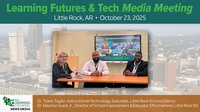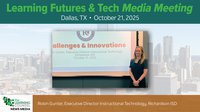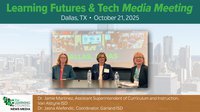In the post-pandemic landscape of education, where the needs of learners are as diverse as the tools available to teach them, the importance of supplemental educational resources cannot be overstated. When thoughtfully integrated with High-Quality Instructional Materials (HQIM), supplemental resources unlock a world of learning possibilities, enhancing both the learning experience and the outcomes for students through a more personalized, inclusive, and engaging educational experience.
Many states are actively working on HQIM initiatives, which form the backbone of a robust educational content strategy. These materials, meticulously designed and aligned with standards, ensure that the core concepts and skills are provided. However, as foundational as it is, HQIM alone cannot address the vast array of learning needs, paces, and interests present in any given classroom. Supplemental educational resources can add layers of depth, accessibility, and enrichment to transform a core curriculum into a dynamic learning journey.
Supplemental resources are versatile and allow teachers the ability to tailor their instruction to meet the unique needs of their students. In classrooms where students come from diverse backgrounds with varying levels of prior knowledge, these materials can bridge gaps and provide scaffolding where needed. For instance, while HQIM might present a standardized lesson on a complex mathematical concept, supplemental resources like interactive simulations, guided practice activities, or concept-specific video tutorials can offer alternative explanations and reinforce learning.
By introducing content that relates directly to students' interests or real-world applications of classroom lessons, supplemental educational resources can make learning feel relevant and engaging. Imagine a science lesson where HQIM introduces the basics of ecosystems. A teacher might supplement this with a virtual field trip to a rainforest, an interactive game where students build their ecosystems, or videos about current environmental issues. These additions not only reinforce the core material but also ignite passion and provide context, making the learning experience richer and more meaningful.
According to Dr. Deann Collins, Deputy State Superintendent for Maryland’s State Department of Education, “The High-Quality Instructional Materials teachers across our state use to support instruction play a key role in awakening student curiosity, and then engaging students in learning. In Maryland, we believe strongly that HQIM has a place in instruction.”
In addition to fostering engagement, supplemental resources play a crucial role in differentiation and personalization. Adjusting the content and delivery of learning to meet students where they are and help them advance at their own pace is critically important in today’s classrooms. For example, advanced students can be provided with challenging problems or extension activities that push their thinking beyond the core material. Meanwhile, students who need more support can access less complex versions of the material, instructional videos that break down complex ideas, or additional practice that build their confidence and skills.
Supplemental resources can also provide the necessary accommodations and modifications to ensure that all students can engage with the curriculum meaningfully. For instance, visual aids, audiobooks, and bilingual resources can make learning accessible to students who might otherwise struggle with standard HQIM.
The role of technology in enhancing the effectiveness of supplemental resources cannot be overlooked. Digital resources, in particular, offer unprecedented opportunities for interactive, personalized, and adaptive learning experiences. These digital tools often come with built-in assessments and progress monitoring, allowing for real-time feedback and adjustment of instructional strategies. This technology-driven approach not only supports differentiated instruction, but also helps to cultivate digital literacy, a crucial skill for the 21st century.
While the development and implementation of HQIM are critical for ensuring a strong educational foundation, waiting for these materials to be fully sorted out before incorporating supplemental educational resources is not a viable option. States and districts face the pressing challenge of meeting educational standards and improving student outcomes in real-time. The reality is that students cannot afford to wait for the perfect set of instructional materials to be developed, approved, and distributed. Supplemental educational resources provide teachers with the tools they need to support students in areas where HQIM may still be in development or where gaps in existing resources are apparent.
Providing supplemental educational resources only after the full implementation of HQIM risks missing out on innovative approaches and timely interventions that can make a significant difference in students' educational journeys. Supplemental resources, especially those that are digitally delivered, can be quickly updated and adapted to reflect the latest educational research, technological advancements, and shifts in student needs. By embracing these resources alongside HQIM, states and districts can ensure that education remains responsive and relevant, providing students with the best possible opportunities for success in an ever-changing world.
After all, the advent of digital supplemental content ranks among some of the biggest innovations over the past 25 years. Today’s students expect that their experience with digital media in the classroom will match their experience outside the classroom. They’ve grown accustomed to dynamic, up-to-date, and relevant digital media in their personal lives, and the supplemental resources provided by the top publishers in this space mirror the content they are interacting with outside the classroom. Supplemental content has been a true game-changer in education.
The integration of supplemental educational resources should not be viewed as a temporary measure or an afterthought but a vital component of a comprehensive content strategy. By leveraging supplemental resources, states and districts can provide a more adaptable, inclusive, and engaging educational experience, ensuring that all students have the opportunity to thrive, regardless of the timeline for HQIM implementation. Supplemental educational resources equip both educators and students with the tools they need to navigate the complexities of learning, making education not just a process of acquiring knowledge, but a journey of discovery, growth, and empowerment.
About the Author
Lance Rougeux, Discovery Education’s Senior Vice President of Curriculum, Instruction, and Student Engagement, began his career as a Philadelphia public school teacher. Prior to joining Discovery Education, Lance served as an Executive Policy Specialist at the Pennsylvania Department of Education.











